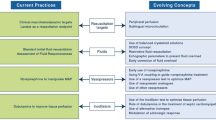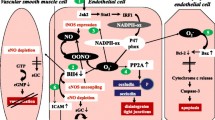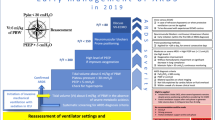Abstract.
This study is to investigate the possible mechanism of beneficial effects of tetramethylpyrazine (TMP) on endotoxic shock which we showed in our preliminary study (Liao et al. 1998; Proc Natl Sci Counc Repub China B 22:46–54). Here, we have confirmed the beneficial effects of TMP on the hypotension, vascular hyporeactivity to noradrenaline (NA), release of tumour necrosis factor-α (TNF-α) and nitric oxide (NO) in a rat model of circulatory shock induced by bacterial endotoxin (E. coli lipopolysaccharide, LPS). In addition, we further examined the expression of inducible NO synthase in the lung and in the aorta from these rats and evaluated the effect of TMP on the 36-h survival rate in a murine model of endotoxaemia. Male Wistar-Kyoto rats were anaesthetised and instrumented for the measurement of mean arterial pressure (MAP) and heart rate (HR). Injection of LPS (10 mg kg–1, i.v.) resulted in an acute fall followed by a substantial fall in MAP within 4 h and an increase in HR. In contrast, animals pretreated with TMP (10 mg kg–1, i.p.; at 30 min prior to LPS) maintained a significantly higher MAP but the tachycardia was further enhanced at 1–2 h when compared to rats given only LPS (LPS rats). The pressor effect of NA (1 µg kg–1, i.v.) was also significantly reduced after the treatment of rats with LPS. Similarly, the thoracic aorta obtained from rats at 4 h after LPS showed a significant reduction in the contractile responses elicited by NA (1 µM). Pretreatment of LPS rats with TMP partially, but significantly, prevented this LPS-induced hyporeactivity to NA in vivo and ex vivo. The injection of LPS resulted in a bell-shaped change in plasma TNF-α level which reached a maximum at 1 h, whereas the effect of LPS on the plasma level of nitrate (an indicator of NO formation) was increased in a time-dependent manner. This increment of both TNF-α and nitrate levels was significantly reduced in LPS rats pretreated with TMP. Endotoxaemia for 4 h caused a significantly increased protein expression of iNOS in the lung and the aorta. In LPS rats pretreated with TMP, iNOS protein expression in lung and aorta homogenates was attenuated by 75±3% and 57±6%, respectively. In addition, the lack of evidence of pressor effect of TMP on rats with endotoxaemia for 4 h suggested that TMP inhibits the induction of iNOS rather than directly inhibiting NOS activity. Treatment of conscious ICR mice with a high dose of endotoxin (60 mg kg–1, i.p.) resulted in a survival rate of only 15% at 36 h (n=20). However, therapeutic application of TMP (10 mg kg–1, i.p.; at 0, 6, 15 and 24 h after LPS) increased the 36-h survival rate to 55% (n=20). Thus, TMP inhibits the expression of iNOS and mitigates the delayed circulatory failure caused by endotoxic shock in the rat. In addition, TMP also improves survival in a murine model of severe endotoxaemia.
Similar content being viewed by others
Author information
Authors and Affiliations
Additional information
Electronic Publication
Rights and permissions
About this article
Cite this article
Wu, CC., Liao, MH., Chen, SJ. et al. Tetramethylpyrazine prevents inducible NO synthase expression and improves survival in rodent models of endotoxic shock. Naunyn-Schmiedeberg's Arch Pharmacol 360, 435–444 (1999). https://doi.org/10.1007/s002109900046
Received:
Accepted:
Issue Date:
DOI: https://doi.org/10.1007/s002109900046




